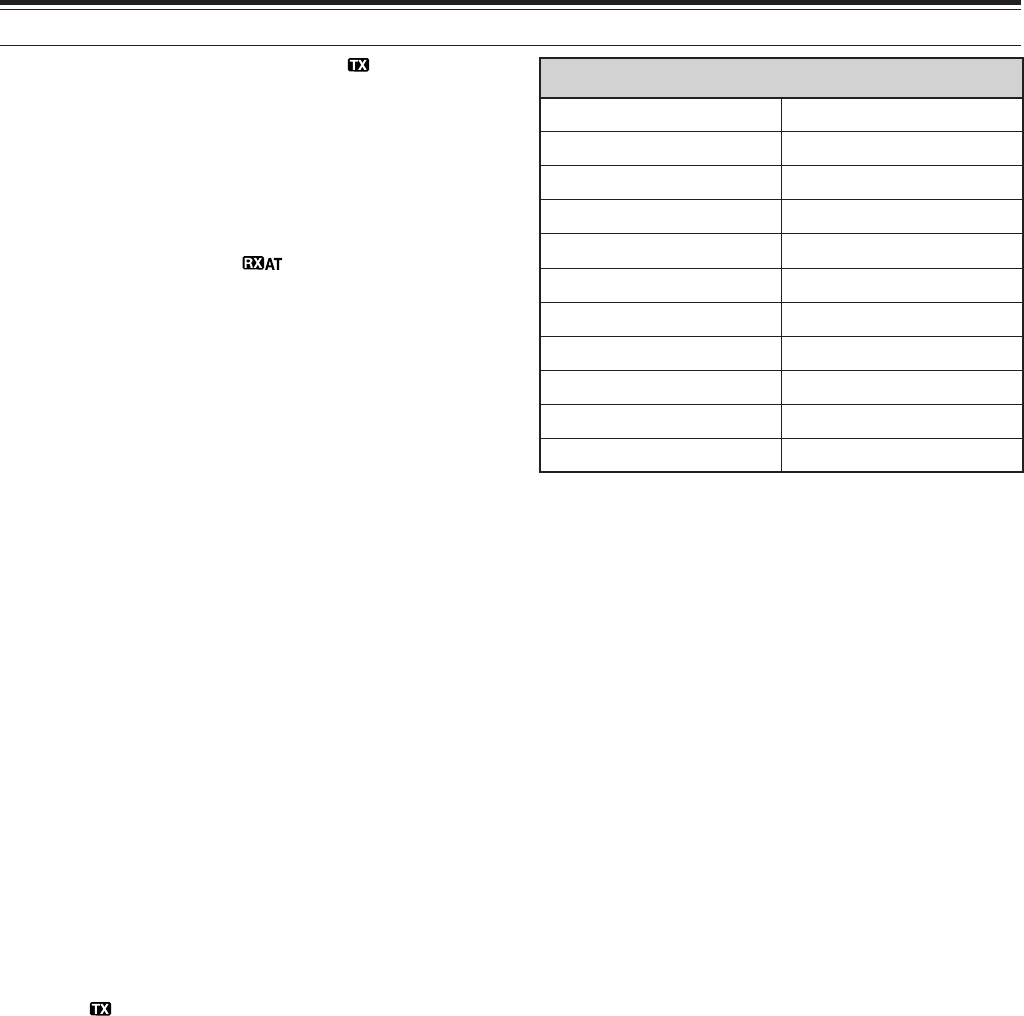
73
15 OPERATOR CONVENIENCES
• If the tuning was successful, “AT ” stops
blinking and the MAIN band red LED turns off.
• If tuning does not finish within approximately
20 seconds, an alarm (“5” in Morse code)
sounds. Press [AT/ ANT1/2] to stop the alarm
and tuning.
If you access Menu No. 27 and select ON, received
signals will also pass through the internal tuner.
When this function is ON, “ ” appears. This may
reduce interference on the receive frequency.
Note:
◆
The internal tuner will not tune outside the available transmission
frequency limits.
◆
Pressing [AT/ ANT1/2] for more than one second while
transmitting, interrupts transmitting and starts tuning.
◆
If you would like to use a separate receiving antenna, access
Menu No. 18 and switch it ON. When this function is ON,
received signals bypass the internal antenna tuner.
◆
While using CW Full Break-in, the internal tuner will be in-line for
both transmitting and receiving.
◆
Tuning automatically turns OFF in approximately 60 seconds.
“AT” disappears and the error beeps stop.
◆
Tuning may still continue when the SWR meter indicates 1:1.
This happens due to the tuning algorithm; this is not a
malfunction.
◆
Even though the SWR meter shows more than one segment, the
internal tuner may not retune. This happens because of an SWR
calculation algorithm tolerance between 10 W (approx.) transmit
power for tuning and 100 W transmit power.
◆
If tuning does not finish even though the SWR meter indicates
smaller than 3:1, adjust the antenna system to lower the SWR,
then attempt to tune again.
◆
Tuning may not reach an SWR of 1:1, depending on the
transceiver conditions.
■ Presetting
After each successful tuning session, the AT
Preset memory function stores the position of the
tuning capacitor in the memory. The position of
the capacitor is stored for each of the antenna
tuner bands (see the following table) and for each
antenna connector (ANT 1 and ANT 2).
Press [AT/ ANT1/2] momentarily.
•“AT” will appear, showing that the internal
tuner is in-line (not bypassed).
• Each time you go across the antenna tuner
band, the AT Preset memory is automatically
recalled to position the tuning capacitor without
the need for retuning. If no preset data exists
for a particular band/antenna combination, then
the default data of 50Ω is used.
Note: Tuning may restart in order to obtain the optimum
matching condition even though the current antenna tuner band
has the preset data.
)zHM(egnaRycneuqerFteserPTA
58.1~30.005.2~58.1
525.3~05.2575.3~525.3
527.3~575.301.4~527.3
30.7~01.401.7~30.7
05.7~01.705.01~05.7
01.41~05.0105.41~01.41
05.81~05.4151.12~05.81
05.12~51.1205.52~05.12
00.92~05.5200.03~00.92
00.15~00.0300.25~00.15
00.35~00.2500.06~00.35
ATTENUATOR
The attenuator function is useful when extremely
strong signals exist nearby your receiving frequency.
When these type of signals exist nearby your
receiving frequency, the AGC function may be
erroneously controlled by the strong signals, rather
than by the target receiving signal. If this happens,
the target receiving signal can be masked and buried
by the strong signals. In this case, turn the
Attenuator function ON.
1 Press [ATT/ F LOCK].
2 “ATT” appears.
To return to the normal operation, press [ATT/ F LOCK]
again.
Note: If the same band is selected for both the main transceiver and
the sub-receiver, the Attenuator function is on for both receivers.
AUTO MODE
You can configure a maximum of 29 points (HF/
50 MHz), 9 points (144 MHz band), 9 points (430
(440) MHz band), and 9 points (1.2 GHz band) of the
main transceiver VFO (VFO A and B) frequencies to
change the operating mode automatically when you
change the frequency.
As a default, the following modes are programmed on
each operating band.
HF/ 50 MHz band
0.03 ~ 9.5 MHz: LSB
9.5 MHz ~ 60 MHz: USB
144 MHz band
142 ~ 152 MHz: FM
430 (440) MHz band
420 ~ 450 MHz: FM
1.2 GHz band (optional)
1240 ~ 1300 MHz: FM
To add the frequency points to the Auto Mode
selection:


















